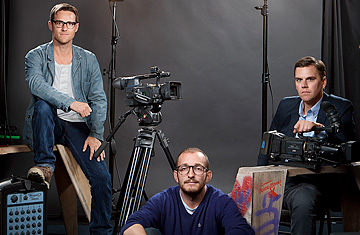
The town of Obo lies on a bend of a remote river in a nameless forest in a country whose name--Central African Republic--is generic.
A few miles from Africa's pole of inaccessibility, its farthest point from any ocean, Obo's 15,000 residents build houses of cane and palm thatch, have neither power nor running water and come together at the town church, where the priest still summons his flock with a wooden drum, or at its rudimentary hospital, which boasts a single doctor. Outside town, in any direction, are hundreds of miles of forest, home to nomads, Pygmies and hippos. Yet Obo is on somebody's map. On a bluff down a dead-end track on the western edge of town, past a police post to which a baby chimpanzee is tied by a string, stands a new construction: a 7-ft.-high (2 m) reed fence enclosing several grass huts. When a TIME photographer and I approach, two stern white faces pop up on the other side. "You're not allowed in here," says one, in American-accented English. "Speak to our public-affairs office in Entebbe [Uganda]." And the face disappears.
What are 30 U.S. special-operations troops doing in one of the most far-flung places on earth? Special ops' code of secrecy notwithstanding, their mission is a matter of public record. In May 2010, Congress passed the Lord's Resistance Army (LRA) Disarmament and Northern Uganda Recovery Act, mandating that the President "eliminate the threat to civilians and regional stability" posed by the LRA. That November, President Obama said his strategy was to back local efforts in Uganda, southern Sudan, the Democratic Republic of Congo and the Central African Republic (CAR) "to maintain pressure on the LRA, both militarily and diplomatically ... specifically, the urgent challenges of apprehending or removing Joseph Kony from the battlefield." That led, in December 2011, to the deployment of 30 special-operations troops to the CAR and 70 more to Uganda, Congo and South Sudan to help advise local forces on how to hunt down the LRA and arrest or kill its leader, Kony.
To which a reasonable response might be "Who?" Or it might have been until March 5, when a San Diego--based advocacy group called Invisible Children released a 29-minute film on the Internet called Kony 2012. Invisible Children called on activists to make Kony the most famous war criminal on earth, thus raising the political will to speed his arrest or death. It was one of many films about the LRA the group has made since 2003, but for some reason Kony 2012 became a phenomenon. Invisible Children wanted 500,000 views. According to the group, the film got a million in 24 hours. After 48 hours, it had a million every 30 minutes. Six days after its release, 85 million people had watched the film, by then translated into 50 languages.
